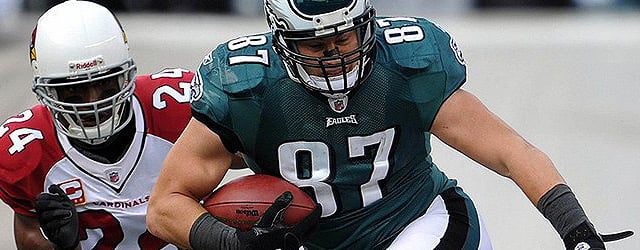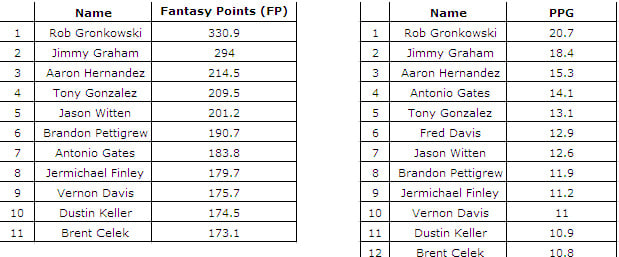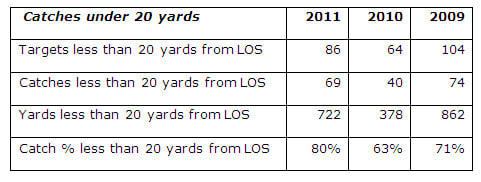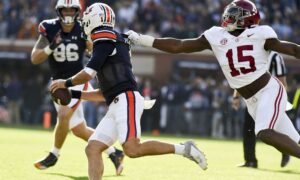Brent Celek – Top Five Tight End?
If I told you Brent Celek was a top five dynasty tight end, would you think I’m nuts? Given that his average draft position is the 14th tight end, that he’s selected around the 11th round in current start-ups, and many rank him lower than 10th, I bet you would.
I assure you, I’m not nuts and I have the analysis to back it up.
2009-2011 Summary
Let’s start with a quick flashback and recap of Celek’s past three years, so we’re all grounded in his performance.
Back in 2009, Brent Celek and Donovan McNabb built a connection that resulted in a breakout season for the young tight end where he finished with nearly 1,000 yards receiving and was the 4th best tight end in standard PPR leagues.
Enter Mike Vick in 2010 and Celek struggled. He finished the year with half of 2009’s production and ranked 18th among fantasy tight ends.
Push forward to 2011 with Vick at it again and Celek improved, finishing with 700 yards as the 11th ranked fantasy tight end.
Overall, his 2011 season was fairly average, which would seemingly destroy my top five proclamation and I can officially be declared nuts. On its face it’s average, but delve into the details of his 2011 weekly performance and he actually returned to his 2009-self – that’s exactly why Celek is deserving of a top five dynasty tight end ranking and why he’s being drastically undervalued. Some owners are snake bitten from 2010 and others recall that year, but don’t see a great 2011 season glancing at his 2011 statistical performance, but there are many positive signs pointing to a top ranking.
2011 Performance Breakdown
It’s time to get into the details. The following depicts how Celek stacked up against the tight end field in 2011 in both total points and points per game from a fantasy perspective:
In both instances, you can see that Celek held firm in his top 12 ranking. That’s probably why his average draft position approximates the 11th tight end and he’s ranked around that same spot by most outlets.
Keep the above rankings in mind – they’ll be important when considering where to rank him going forward as discussed at the end of this section below.
While he hovered around the 11th tight end overall, if we look at a weekly breakdown of his 2011 performance, it’s clear that something happened right before the Eagle’s week seven bye:
1) The extrapolated 2011 numbers would rank Celek as the 3rd best tight end in 2011.
2) The extrapolated 2011 points per game is 14.2, which would rank Celek just behind Aaron Hernandez as the 4th best tight end.
3) If you aren’t comfortable extrapolating his TDs and you keep them flat at 5, he would still rank as the 3rd best TE in 2011 without them.
4) His 2011 extrapolated numbers are eerily similar to his 2009 numbers.
Based on the above, there’s merit to ranking him as a top five dynasty tight end. However, many are still skeptical. The most common concern is that we don’t know why 2010 occurred and that it won’t be repeated again.
What Happened in 2010?
I decided to dig into 2010 a bit more to try and determine why the drop-off in performance occurred and to assess if it’s likely to occur again. Before looking at the statistics, my hypothesis was that Celek’s 2010 struggles were a result of three things:
a) Vick’s inaccuracy / Celek and Vick were not in sync in 2010
b) Celek was used more as a blocker in 2010
c) Celek was not used in short and intermediate routes in 2010
Vick’s inaccuracies / Celek and Vick Not In Sync
Since Celek does most of his damage over the middle (70% of his targets), I decided to take a look at his performance in that area since it would be most representative. Looking at his statistics in ten yard increments and comparing each of the three seasons, there’s a sizeable difference in his catch percentage over 10 yards in 2010. Here are the numbers that were pulled:
If we were able to split the above information for the final 11 games of the season, I believe we’d see an increase in Celek’s catch percentage over the middle and also in the ten yards plus range as compared to the above. Based on the weekly breakdown of Celek’s performance earlier, the tight end / quarterback chemistry appears to have stuck beginning in week six through week 17, which bodes well for Celek going forward. I’d expect an increase in the above 2011 numbers going in 2012, as a result.
While this is positive information, it’s not the biggest contributor to the 2010 decline. There’s a stronger catalyst detailed below.
Celek used as a blocker more in 2010
I won’t post the tables of statistics here because they’re lengthy, but I found no substantial difference between the 2009/2011 blocking rate and 2010. There was a slight spike of approximately 3% in 2010, but that’s not likely to have a meaningful impact. I was wrong on this one based on the information I have.
Celek not used in short/intermediate routes
This is where I really found the driver.
When looking at the 2009 catch breakdown, it was clear that Celek made a living in the short-intermediate areas and racked up a ton of yards after the catch. There’s also a quote from Andy Reid from the 2010 offseason where he discusses that they need to get Celek back involved in the short and intermediate passing game.
Sure enough, when you look at the statistical breakdown from the past three seasons, Celek’s 2010 targets, catches and yards decreased significantly under 20 yards and under ten yards from scrimmage. In 2011, his targets, catches, and yards spiked back up close to the 2009 level. Take a look:
There’s a similar pattern less than 20 yards from scrimmage:
If we were able to bifurcate weeks one through five and the remainder of the season and extrapolate week six forward for a full season, I’d venture to guess that they’d be even better and closer to his 2009 numbers.
The bottom line is that in 2010, Celek wasn’t used in the short and intermediate area of the field where he excelled in 2009. That was rectified in 2011 and it showed in his final numbers and, thus, there’s no need to be concerned with a Celek decline going forward.
Conclusion
It’s simple… Celek deserves to be considered as a top five dynasty tight end and he isn’t currently.
If you’re concerned about being burned like many were in 2010, don’t be. The above shows that there was a clear transition period from Donovan McNabb to Michael Vick that resulted in underutilization of Celek in the short and intermediate passing game, as well as chemistry issues arising between Vick and Celek. Both issues appear to be resolved and Celek is back to his 2009 top five tight end form.
Still think I’m nuts?









































































